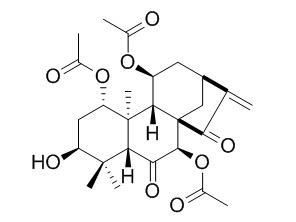Natural Products
Adenanthin
| Catalog No. | CFN99215 |  |
| CAS No. | 111917-59-0 | |
| Molecular Weight: | 490.6 | |
| Molecular Formula | C26H34O9 | |
| DBs | [PubChem]:274950935 [ChEMBL]: [PCIDB]:40862 |
Standard InChI:
InChI=1S/C26H34O9/c1-11-15-8-17(33-12(2)27)21-25(7)19(34-13(3)28)9-18(31)24(5,6)20(25)16(30)10-26(21,22(11)32)23(15)35-14(4)29/h15,17-21,23,31H,1,8-10H2,2-7H3/t15?,17-,18+,19-,20-,21+,23?,25-,26-/m1/s1
Biological Activity
Adenanthin , a diterpenoid isolated from the leaves of Rabdosia adenantha , induces differentiation of acute promyelocytic leukemia (APL) cells, it can serve as what is to our knowledge the first lead natural compound for the development of Prx I –and Prx II –targeted therapeutic agents, which may represent a promising approach to inducing differentiation of APL cells.[1]
Adenanthin can represses tumor growth and prolongs survival in mouse promyelocytic leukemia models, but it is not a specific Prx inhibitor, and its reported antitumor and anti-inflammatory effects are more likely to involve more general inhibition of thioredoxin and/or glutathione redox pathways.[2]
Adenanthin, a new inhibitor of thiol-dependent antioxidant enzymes, impairs the effector functions of human natural killer cells.[3]
Adenanthin can induces monocytic differentiation of the ATRA-sensitive and-resistant leukemic cells through MEK/ERK2/C/EBPβ pathway.[4]
Adenanthin inhibits the expression of telomerase through Prdx Ⅰ and contributes to the death of cells.[5]
Product
References
[1] Wu Y L, Pu J X, Liu W, et al. Nat Chem Biol, 2012, 8(5):486-93.
[2] Soethoudt M, Peskin A V, Dickerhof N, et al. Free Radical Bio Med, 2014, 77:331-9.
[3] Marta Siernicka †, Magdalena Winiarska †, Bajor M, et al. Immunology, 2015, 146(1):173–83.
[4] Liu Zhuanxu. China Pathophysiology receptors, tumor immunity and Professional Committee Joint Conference Papers Series 2010.
[5] Cui J Y, Cao Y, Lei H, et al. J Shanghai Jiaotong University, 2015, 35(1).
Product Use Citation





